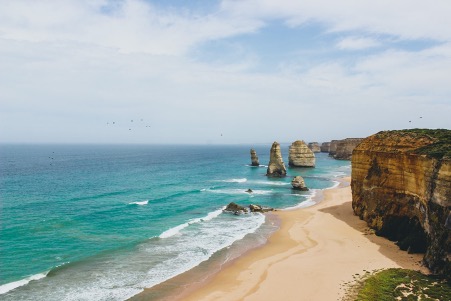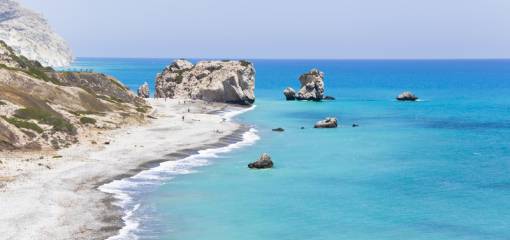The Great Ocean Road is one of the most famous coastal routes in the world. It is truly a stunning coastal road and we highly recommend adding it to your Australia travel bucket list.
The Great Ocean Road stretches 243 km from Torquay to Allansford along Australia's southeastern coast. You can drive it in a day, but to really enjoy it, you should take at least a couple of days to see what the region has to offer.
Built between 1919 - 1932 by soldiers returning from World War I, it is the largest war memorial in the world, once linking isolated settlements along the coast.
Read our blog and check which are the top 5 places to visit on your Great Ocean Road Trip.
1 Bells Beach
What is the most famous surfing beach in Australia? Yes, it's Bells Beach about five kilometres southwest of Torquay, where the Rip Curl Pro Surfing Competition is held every March. Torquay turns into a festival-like atmosphere when the Rip Curl Pro rolls into town. The cliff edge provides entertainment during the day and at night the town takes over the festivities.
Bells Beach's huge waves creep one by one into a large bay overlooked by impressive cliffs. The view from the cliff platform is spectacular and a great place to watch the surfers perform their acrobatics.

2 Kennet River Koala
To be in Australia and not see a koala would be a sin. And if you've never seen a koala, you're in for a treat. The Kennett River Koala Walk winds along Grey River Road through dense eucalyptus trees in the Otway Rainforest and is the best viewing spot.
There is a rest area for coaches and a toilet at the caravan park. The caravan park has a small shop and a café if you fancy ice cream. You can walk a few hundred metres along a rough path, there are eucalyptus trees on either side. Walk along the path and look up at the eucalyptus trees, you may find them sleeping. There are also many parrots and other wild birds for you to admire.

3 Apollo Bay
Visiting Apollo Bay is an adventure. Explore nature's backyard with sheltered coves for swimming, and endless hiking trails in Great Otway National Park, or enjoy a great meal sampling local food and wine.
The Great Otway National Park stretches from Torquay to Princetown and through the Otways hinterland to Colac. The park features sandy beaches and rugged coastlines, rock platforms, magnificent waterfalls and lakes, and dense green forests.
Apollo Bay is about halfway along your Great Ocean Road journey. For the perfect vantage point of the town centre, harbour and beaches of Apollo Bay visit Mariners Lookout. The viewpoint is on private land but has been opened to the public by a local couple who provided the path and land as a contribution to the Shire. It is located at the northern end of the town. From the town, there are many short or multi-day hikes you can take to explore the Otways Rainforest. If you are more of a sporty type, the town is a good base for cycling, horse riding, kayaking or flying over the coast.

4 The Twelve Apostles, Port Campbell National Park
One of the most popular stops on the Great Ocean Road trip is to visit Port Campbell National Park. The park features cliffs overlooking the Southern Ocean and houses several tourist attractions such as The Twelve Apostles, The London Arch, Loch Ard Gorge, The Grotto, Gibson Steps etc.
The Twelve Apostles are one of the most famous highlights of the Great Ocean Road journey. Although there are no longer twelve, this is by far the most popular of all the things to do on the Great Ocean Road. At one time, 12 stacks of limestone shot up to 45 metres out of the water, offering stunning views of the coastline. Until the 1960s, the area was nicknamed "Sow and Pigs", with Muttonbird Island representing the sow and the limestone stacks representing the pigs. For marketing purposes, they then created the Apostles, which slowly became the 12 Apostles.
The Twelve Apostles formed about 20 million years ago, and the sea gradually eroded the limestone cliffs, forming caves and arches and eventually isolating the rocky islands from the coast. Fierce ocean storms still roll in each year, causing further erosion of up to two inches per year. Behind the eight remaining stacks (five have toppled since their discovery) are majestic cliffs some 70 metres high. If you have the chance, visit them at sunrise or sunset to enjoy the beautiful light show. This way you will also avoid the tourist buses.
If you have time and money to spare, you can also enjoy these incredible rock formations from above. Join a helicopter tour for a 15-minute flight and experience a truly unique perspective on the breathtaking landscape.

5 Highlights of The Port Campbell National Park
The Arch is one of the most spectacular highlights of Port Campbell National Park, along with the shipwreck Loch Ard and London Arch. This naturally formed arch is 8 m high and is located 6 km west of Port Campbell. You will appreciate the power of the ocean crashing against the arch, it makes the drama of the place even better.
The beauty of this place is that with two viewing platforms, you can go quite deep into the water and experience the crashing of the waves from much closer than other places along the Great Ocean Road. It only takes a few minutes to walk down the sealed path to the viewing platforms and you'll be glad you did. The first 50m of the path is level, but the last 100m drops off steeply. The main viewing platform is easily accessible for wheelchair users, but the lower, smaller one is not.
The London Arch (formerly London Bridge) is also an incredible sight and also has an interesting history. Before 1990, London Bridge was a bridge connecting the land arch to the mainland. That year, part of the bridge collapsed into the ocean, leaving a piece of land isolated in the ocean. And left 2 tourists on the island who had to be rescued by helicopter.
London Arch is one of two points in National Park, where visitors can watch little penguins returning to shore (the other is from the main 12 Apostles observation deck).
If your interest doesn't end at observing the ocean and its rock formations, we recommend bringing your binoculars and enjoying the abundant birdlife. Port Campbell National Park's fauna is largely ornithological, so keep your eyes peeled for honeyeaters, emus and wrens, as well as pelicans, peregrine falcons, ducks and black swans.

Useful tips for your Great Ocean Road trip:
- Instead of taking a bus tour, drive your own car, so you have the freedom to stop anywhere you want. This is a road you have to experience behind the wheel to not miss any of the spectacular views on this Great Ocean Road trip.
- You can hire a camper, caravan or motorhome to have the best self-drive experience. Waking up to the sunrise with an ocean panorama should be one of your experiences.
- Fill up your car with gas as there can be long distances between gas stations.
- Don't be in a hurry. You may only witness this great view from The Great Ocean Road Trip once in your life.









